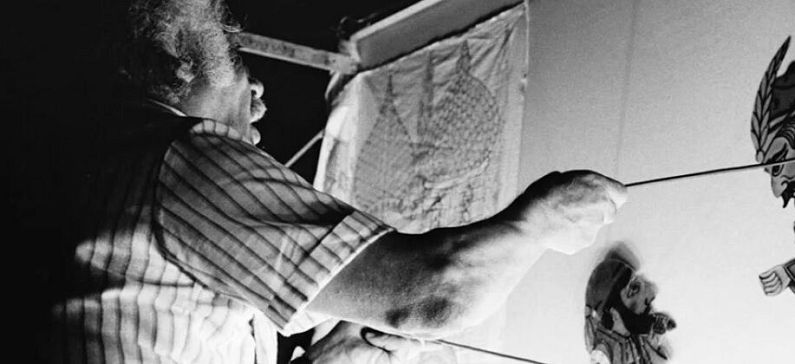
The representative of the Greek Folk Tradition who left architecture for the shadow theatre
He is recorded in the consciousness of all of us as the “father” of Karagiozis and one of the first exponents of the shadow theatre, who brought up generations. But Eugenios Spatharis was much more than that, even though he loved it more than anything else.
He was born today in 1924 and grew up in Kifissia. He learned the art of shadow theatre next to his father, Sotiris, where he watched him perform at Platanos, where the Kifissia Grove is located today. As a boy he had a dream of becoming an architect, but luck was not on his side. The time for his studies coincided with the years of occupation, and so, since he could not continue them during the war, he devoted himself body and soul to the Shadow Theatre and Karagiozis.
With his passion and dedication, Spatharis, in a very difficult time for Greece, managed to make the shadow theatre and his beloved Karagiozis known throughout the country, giving performances from one end to the other. Everyone learned about Hatziavati, Barbagiorgos, Kollitiri, Sviras and Pirigogo. He played in theatres, cinemas, squares, cafes and even in homes. In fact, the reputation of the clown was so widespread that when the historic experimental television station was created in 1966, the programme began with a performance by Eugene Spatharis.
“How Turkish is Karagiozis after all?”
The fame of Karagiozis and Spatharis quickly transcended domestic borders. In fact, he had even started another argument with our neighbours, the Turks, about whether the folk hero’s origins were Turkish, as in his stories, he usually picks on… Sarai. Below, how Spatharis himself describes a verbal attack he had received from a Turkish representative at the 1959 Paris Festival of the Theatre of Nations in Paris, in an interview with the newspaper “Acropolis” in 1978:
“It was in 1959, at the Festival of the Theatre of Nations, in Paris, where I was invited by the French, despite the objections of the Greek ambassador there at the time to the “Turkish show” that I was going to present as a Greek show.We were all gathered in a press – representatives from theatres all over the world, numerous journalists, embassy attachés and many others. “The Shadow Theatre is Turkish and not yours,” the Turkish representative suddenly attacked me in front of everyone.– “I’m not going to tell you at first that it is ours,” I replied. But am I going to ask how it is yours? How can it be yours when the Koran forbids such shows. How is it yours when it has lived in Java for 750 years, in Thailand and the Indies for 600 and 1,250 in China and you have had it -you say- for 200 years? How is it yours when in the Eleusinian Mysteries the ancient Greeks played behind bairns with lit torches to show their shadows? How is it yours when a Greek traveller, Yannis the Mavrommatis (Karagiozis = Mavrommatis) brought you the shadow theatre from China, whom you have already buried in Prusa, near Bania, under some cypress trees? The Shadow Theatre is neither yours nor ours, Its roots are lost in the past”.
The painting
Spatharis was a multifaceted artistic personality. He may have been remembered for his shadow theatre, but apart from his performing talent, he also had an aptitude for painting, with a particular style through which he combined the basic characteristics of folk painting with vivid colours and realism.
He drew his subjects from everyday images of old Athens, historical events, heroes of the revolution, folk songs, mythology and fairy tales.
He began to paint the advertising posters of his father’s shows and then his own and when he realized that he could express himself through colours, he easily moved on to other subjects and quickly evolved in the field of painting theatrical scenery and costumes, where he gained a lot of experience.
He was involved in the illustration of many children’s books as well as in the illustration of calendars for well-known major companies.
In February 2007, the Ministry of Culture and Mr. Giorgos Voulgarakis honored Eugene Spatharis for his valuable contribution to art and to our Greek folk tradition by awarding him a commemorative plaque and by organizing an event dedicated to the sixty-five-year action of the theatrical epilogue of the heroic plays, which was usually performed with the bardé down by the clown himself and his assistants.
Lastly, he was one of the first founders and ardent supporters of the Panhellenic Carpenters’ Association, which was formed in 1924.









